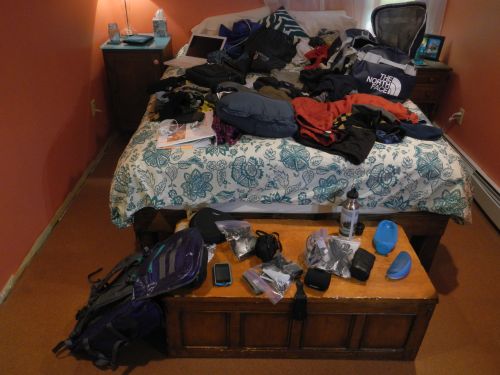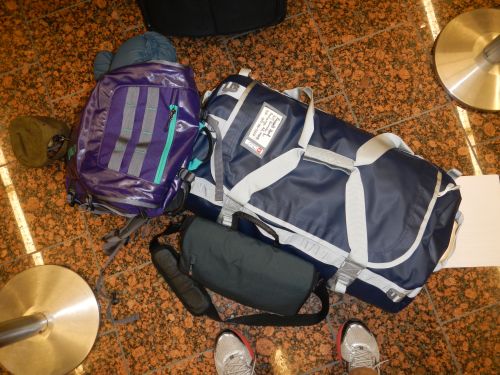I'm off!
After packing and repacking last night I finalized my gear and am ready to go. The total weight of everything I'm taking checks out as follows:
Luggage by the numbers:
- Checked bag: 30 lbs - Has all of my clothes and little else
- Carry on: 17 lbs - This is almost entirely full of electronics
- Laptop bag: 7 lbs
- Total: 54 lbs. = 24.5 kg.
- Volume of luggage is approximately 8000 cubic inches = 131 L = 0.131 cubic meters
- Average density of luggage is mass ÷ volume = 187 kg/cu.m (it would float in water - hopefully that's never tested)
Here's a photo off all of my gear set out on our guest bed:

And here's what it looked like sitting at my feet before check-in in Anchorage.

I wanted to be portable enough so that I could carry everything myself without having to get a cart. My carry-on bag suggests that I recently looted a Radio Shack as it includes the following contents:
- Digital video camera, battery, storage card
- Two digital cameras, batteries, cords, and charging cables
- A Labquest data gathering device, complete with USB cords and AC adapter
- Probes for the the Labquest above include one light probe, two temperature probes, and one microphone
- One AA/AAA battery charger
- Noise canceling headphones and cords
- Cell phone with charger
- Binoculars
- Flames and Dusty: The two stuff animals my kids chose to accompany me. Dusty is a muskox (might see one in Greenland) whiles Flames is a red dragon (not so sure I'll see that).
Flying to Greenland this time of year is not easy as you can see here:
.be
How did Greenland get its name?
This question arose in one of my classes and at the time I answered cynically "It was all about marketing" as that's all I could remember(at the moment) from my history classes. According to Norse history, Eric the Red, exiled from Iceland in AD 982 for murder, spent three years living in southern Greenland before returning to sailing back home. Returning to Iceland he described a "Greenland" as a place people could settle and make use of the resources. The marketing worked as he and quite a few Icelanders would return in AD 985 to establish permanent settlements.
Is it possible to fly as fast as the sun revolves around the earth?
This question arose in my family as we discussed the details of my flight itinerary. Flying eastbound you "lose" a lot of time while travel westbound it is possible to land before you left. (You could also pull this off with an short eastbound journey near the international date line.) Let's look at the numbers:
The earth is 6380 km in radius which means that it has a circumference of 2πr = approx. 40,000 km. A person on the equator will rotate through this distance in 24 hours which means their average speed would be v = 40,000 km ÷ 24 hours = 1670 km/hr (≈ 1000 mi/hr). Any plane flying at the equator would have to fly this fast, westbound, to keep up with the apparent movement of the sun. The problem is that 1000 mi/hr is much faster than the speed of sound and hence much faster than commercial aircraft fly (we wouldn't want EVERY plane in the sky to be creating sonic booms, would we???). Most typical jet planes cruise at about 900 km/hr (≈ 550 mph). But there's a way around this "slow" speed issue. The distance a person rotates around the earth's axis in one day is much lower locations at higher latitudes than it is at the equator. For instance, at a latitude of 60º (just south of Anchorage, AK) the circumference of the earth is one half that at the equator. So an observer there would perceive the sun as traveling 20,000 km in 24 hours for an average speed of 835 km/hr ≈ 500 mi/hr. Since planes travel faster than that a plane flying westbound along the 60 degree latitude would in fact travel faster the sun. To put this in perspective you could do the following trip.
You are at 60º north latitude. You wake up and watch the sunrise before boarding a jet airliner. The sunrise was so spectacular you wish to see it again (and you can't wait until tomorrow). If you leave just after sunrise and fly westbound for 10 hours you will land about one hour before the sun arrives at that airport. This time you better have your camera ready!
Question of the day for trigonometry-capable students: What is the exact latitude you would fly along so that you travel exactly the same speed as the sun tracks across the earth? Such a westbound flight, if done right at sunset, would have the pilots flying "into the sunset" during the entire flight - that would be pretty cool!
I'll update my journal as best I can during my flight over there, but I have hardly slept much the last three nights and getting some rest will be a priority. As sad as it is to leave my family I am also excited about the trip to come.
Greenland here I come!!!


Comments